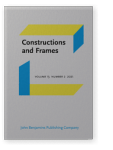Vol. 13:2 (2021) ► pp.263–308
Another look at the interaction between verbs and constructions
The case of resultatives based on wipe
Despite the wealth of literature on English resultatives, there still remain a number of issues that have not been squarely addressed. This paper addresses two of them through a case study of resultatives based on wipe. First, while the existence of resultatives with objects not selected by verbs is well-known in the literature (e.g., wipe the crumbs off the table/*wipe the crumbs), few studies have addressed the issue of exactly which entities may appear as non-selected objects. Second, there are resultatives whose form is to be analyzed as a mixture of the verb’s lexically-specified syntactic frame and the syntactic frame of resultatives (e.g. wipe the blade clean on his skin coat), but such resultatives have been neglected in previous studies.
In order to find an answer to the first issue, this paper adopts a force-recipient account, according to which the post-verbal NP of a resultative is a force-recipient (cf. Croft 1990, 1991, 1998, 2012). It is shown that non-selected objects like crumbs are indeed force-recipients in a conceptual scene. As for the second issue, such resultatives can be accommodated by means of a constructional analysis which holds that verbs contribute the semantics of the resulting expression, and that argument structure constructions simply enable the verb meaning to take its form. Together, these findings indicate that verbs play a far more important role than argument structure constructions in effecting the syntax and semantics of the resulting expression.
Article outline
- 1.Introduction
- 2.Resultatives based on wipe
- 2.1Previous analyses
- 2.2Resultative caused-motion sentences
- 2.3Resultatives based on ‘wipe – on NP’
- 2.3.1Two distinct senses of wipe
- 2.3.2Reference needs to be made to lexically-specified syntactic frames
- 2.3.3Interim summary
- 3.A force-recipient account and frame semantics
- 4.Resultatives based on ‘wipe’
- 4.1Frame semantics of wiping
- 4.2Wipe the crumbs off the table
- 4.3Wipe the blood off his face
- 5.How form and meaning are related
- 5.1Two operations
- 5.2Resultatives are compositional, after all
- 6.Resultatives based on ‘wipe – on NP’
- 6.1The status of the post-verbal NP in ‘wipe – on NP’
- 6.2Wipe the blade clean on the coat/wipe blood from the blade on the coat
- 6.3Composite syntactic form
- 7.Still another apparent puzzle posed by wipe – clean
- 7.1Surface type objects vs. non-surface type objects
- 7.2Possible origin of wipe – clean with non-surface type objects
- 8.Conclusion
- Acknowledgements
- Notes
-
References
